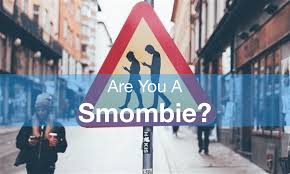Smartphone addiction in South Korea
韓國(guó)人對(duì)智能手機(jī)依賴成癮
Smombie apocalypse
“低頭族”末日
In South Korea smartphone cases come with rings mounted on the back, to prevent clumsy owners from dropping them. This makes people look like they are literally married to their phones. In many of Seoul’s most Instagrammable coffee shops, couples on dates spend vastly more time looking at their screens than at each other. The ramifications go beyond the potentially dire consequences for romance.
在韓國(guó),智能手機(jī)保護(hù)套的背面裝有指環(huán),以防笨手笨腳的主人滑落手機(jī)。這看起來就像人和手機(jī)結(jié)婚一樣。在首爾許多網(wǎng)紅Ins咖啡店里,情侶們?cè)诩s會(huì)時(shí)盯著屏幕的時(shí)間要遠(yuǎn)遠(yuǎn)多于盯著對(duì)方的時(shí)間。這不僅會(huì)破壞他們之間的浪漫,而且還會(huì)帶來其他后果。

Walk around the streets of Seoul or any other South Korean city, and there is a real risk of bumping into people whose eyes are glued to their smartphone screens. Insurers estimate that around 370 traffic accidents annually are caused by pedestrians using smartphones. That figure does not include those who bump into lamp posts and the like while perusing the latest cat videos.
走在首爾或其他韓國(guó)城市的街道上,很容易撞到目不轉(zhuǎn)睛盯著智能手機(jī)屏幕的人。據(jù)保險(xiǎn)公司估計(jì),每年約有370起交通事故是由行人走路看手機(jī)造成的。這一數(shù)字還不包括那些在觀看最新喵星人視頻時(shí)撞到燈柱等物體的人。
The government initially tried to fight the “smombie” (a portmanteau of “smartphone” and “zombie”) epidemic by distributing hundreds of stickers around cities imploring people to “be safe” and look up. This seems to have had little effect even though, in Seoul at least, it recently replaced the stickers with sturdier plastic boards.
“低頭族”一詞“smombie”是由“smartphone智能手機(jī)”和“zombie僵尸”合成,這種人越來越多,政府最初試圖通過在城市周圍分發(fā)數(shù)百?gòu)堎N紙呼吁人們注意安全,抬頭看路。這種做法似乎收效甚微,盡管最近,至少在首爾,政府用更結(jié)實(shí)的塑料板取代了貼紙。
Instead of appealing to people’s good sense, the authorities have therefore resorted to trying to save them from being run over. Early last year, they began to trial floor-level traffic lights in smombie hotspots in central Seoul. Since then, the experiment has been extended around and beyond the capital. For the moment, the government is retaining old-fashioned eye-level pedestrian lights as well. But in future, the way to look at a South Korean crossroads may be down.
因而,政府是將“低頭族”從車禍中拯救出來,而不是喚醒其安全意識(shí)。去年年初,開始在首爾市中心“低頭族”多見區(qū)域試行地面交通燈。從那之后,這個(gè)實(shí)驗(yàn)逐步擴(kuò)展到首都周邊甚至更遠(yuǎn)的地方。目前,政府還保留了老式的與眼睛水平的行人信號(hào)燈。但在未來,在韓國(guó),看紅綠燈的方式可能會(huì)有所改變。
譯文由可可原創(chuàng),僅供學(xué)習(xí)交流使用,未經(jīng)許可請(qǐng)勿轉(zhuǎn)載。












